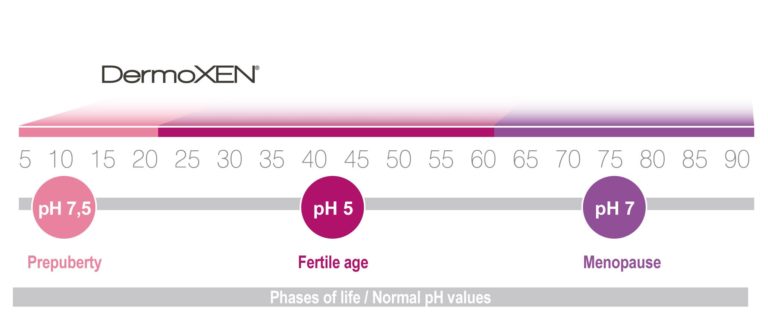Find out your pH and choose the best intimate cleanser for you
Do you know that your vaginal pH changes
according to the period of your life?
A proper intimate hygiene is the main ally of your daily well-being and it starts necessarily with the choice of the best cleanser for your intimate area. Indeed, it is a good rule to choose a specific intimate cleanser, different from the products that you use for body cleansing, since your genital area has a different pH compared to the other parts of your body.

A good product for intimate hygiene must have four basic characteristics:
In women, vaginal ecosystem is naturally protected by Döderlein’s bacilli, a family of “friendly” bacteria that live in the vagina and produce lactic acid, a substance that creates a hostile environment to the attack of harmful bacteria. In this process, the role of the oestrogen is fundamental. It stimulates the production of glycogen, used by Döderlein bacilli to produce lactic acid. The level of oestrogen changes according to a woman’s period of life, therefore the level of acidity of the vaginal environment also changes. Since acidity is measured by pH values, this means that a woman has different vaginal pH values according to her age.
Up to puberty, the quantity of oestrogens in girls is poor, as well as the presence of glycogen. In these conditions, Döderlein’s bacilli are absent and the vaginal pH is quite neutral. This means a risk of infections for little girls, because the vaginal ecosystem has no effective defenses.
In fertile age, vaginal pH ranges between 3.5 and 4.5; this is possible thanks to the production of lactic acid that keeps stable acidic pH levels.
In pre-menopause and in menopausal women, the oestrogens are produced irregularly and slowly disappear completely. Therefore, the vaginal pH is too similar to little girls’ one. In addition to the high risk of infections, there are events of dryness and itching, due to the thinning of the vaginal epithelium and to reduced lubrication.
For these reasons, your intimate cleanser should protect the vaginal ecosystem and preserve its natural acidity (pH) in every stage of your life. Therefore, it is not correct for a little girl to use the same cleanser used by her mother for her intimate hygiene.
In intimate cleansers, the function of these compounds is that of trapping impurities and remains that will be rinsed off. However, if they are too aggressive, surfactants can weaken Lactobacillus bacteria, so they are no longer able to keep the right level of acidity. Furthermore, they can damage the superficial layer of genital mucous membranes, causing a loss of resistance of the surface and facilitating the proliferation of pathogens.
For example, Sodium Lauryl Sulfate (SLS) and Sodium Laureth Sulfate (SLES) are the most commonly used surfactants in cosmetics, but also those causing the greatest irritating effects and skin sensitisation.
Parabens and Thiazolinones are synthetic preservatives widely used in cosmetics because they are able to prevent microbial growth in the cosmetic product and allow to extend its shelf life. On the other hand, these ingredients can cause skin irritation, allergic reactions and other damages on the skin and mucous membranes, widely acknowledged by the international scientific literature.
The presence of high allergenic chemical substances in the fragrance of cleansers, which come into contact with the genital mucous membrane everyday, can indeed give rise to annoying reactions such as itching and burning.


